The day before I interview Marcus Wareing – the venue is to be his Michelin-starred restaurant, Marcus, at the Berkeley hotel in Knightsbridge – two things happen. The first is that I have an odd phone conversation with a publicist for his cookbook, in which she informs me that Wareing is keen for me to take a “fresh and new” approach, that he’s tired of everyone writing the same old stuff, and that he wants to talk about the future, not the past – a future, by the way, that doesn’t involve standing at a stove all day long.
The second is that I receive an email from another publicist, this one at a company that does PR for Wareing’s restaurants. It begins by giving me directions, but soon segues into more of the same. She is, it seems, delighted I will offer a “fresh, new perspective” on her client, who these days is very happily able to spend much more time with his family.
Well, you can imagine how all this goes down with me, and perhaps because I feel a bit grumpy about it, once I’m safely ensconced at a table at Marcus with Marcus – it’s 9.30am, which is good in the sense we have the place to ourselves, but bad in the sense there will be no veal sweetbreads or smoked Anjou pigeon for me today – I put this to him. “Your people have told me that it’s all change with you,” I say, confidently. And then, a bit less confidently, because I’ve seen the look on his face: “Apparently, you’re not in the kitchen any more. Apparently, you want to focus on other …” My voice, weedy now, trails off.
There is a tiny silence, and then he replies. “That phrase: ‘not in the kitchen’. Let’s be clear. I run my company in my chef’s jacket. I am here, every day, standing at the pass. I watch, and I guide, and I taste. The difference is, I’m not on the kitchen side of the pass, sweating, breaking everyone’s balls. I’m at the other side now. Because I don’t want to be like some chefs, in their 50s and 60s still standing in the kitchen with a big hat on. I don’t want to do that. We don’t look at chefs who’ve done every single service and think that’s cool any more. In France they might do. But here, we don’t. My chef theory is that I have to allow my youth to grow underneath me. I’ve got three restaurants, and maybe one day, I’ll have four or five. But only if I’ve got the talent to do it. So I have to step to the side.”
I’m taken aback by his tone, which is testy, almost affronted, even though, in the end, it seems he doesn’t really disagree with my proposition: he isn’t in the kitchen any more. But as I will discover, this is Wareing all over: defensive, even when on the receiving end of praise; hyper-alert to criticism, even when none is intended. Like an unattended pan, you feel he could boil over at any moment. His smile doesn’t always reach his eyes. Add to this the weird motivational manual he seems to have swallowed, whole and unseasoned (“I love business! I love LBC radio!”), plus his tendency to refer to himself in the third person (“The feedback was that Marcus doesn’t do sharing plates”), and the thought does occur that he is inordinately well named.
The restaurant, which he relaunched in 2014, is cool and quiet, the only sound a waiter diligently ironing tablecloths. Which makes me think. Has Brexit had any effect on business? Wareing believes it will take a while – if, that is, there is to be any dip at all. “When I took over here in 2008, it was the start of the recession,” he says. “It took a year for it to impact. Corporate entertaining got strictly controlled, and private money was much more cautious about its spend ... Look, I’ll be honest. I voted to stay in. But I love the new government. Let them get on with it. You have to look at the positives. It’s new. It’s fresh.” At this point, I resist the temptation to say: just like you.
All three of his restaurants – the other two are the Gilbert Scott, at St Pancras station, and Tredwell’s, a brasserie at Seven Dials, Covent Garden – are, he says, thriving. Tredwell’s, of course, initially had a bit of a thwacking from the critics though he feels these attacks were mostly personal.
“There was one in particular … But I discarded it in my head. It’s only because you bring it up that I remember it, though quite frankly, I don’t give a shit.” Actually, this is unfair: he brought up the critics, not me. But since he has, does he feel any of the criticisms were justified? “What was being said was that Marcus can’t cook. Well, I can cook, and my team can cook.” All the same, he put his group operations director, Chantelle Nicholson, into the kitchen as chef-patron after the reviews. So things are smoother now? “Why? Do you think it’s failed?” No, but … “One thing that didn’t work out was the sharing plates. That made me realise how pigeonholed I am, how hard it is to break out of the mould of fine food. How come Hawksmoor can [serve sharing plates]? How come Jamie Oliver can?”
Isn’t it great to be known for a certain kind of excellence? “Yes, but I want to diversify.” So he would, perhaps, like to roll out Tredwell’s? “Don’t you dream of things?” So he does want to roll it out? “No! It was only ever going to be one restaurant.”
My god, this is tiring. But perhaps some part of him needs it: the constant tussle. We all remember his legal battles with Gordon Ramsay, skirmishes he has always claimed to have enjoyed (in 2008, they fought publicly over Petrus, the Berkeley having announced that Wareing would be taking on the lease of the two-Michelin-starred restaurant, of which he was then head chef; Ramsay eventually kept the name, but the row enabled his protege to escape what he described as his mentor’s “interference” in his kitchen, and go it alone by opening Marcus).
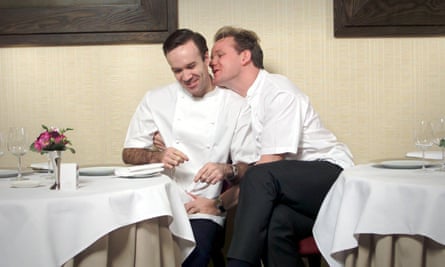
Such pugnacity seems just to be another aspect of his extraordinary work ethic, a drive that was instilled in him by his father, a Southport fruit and veg merchant with whom Wareing used to work in school holidays – and one which he is now trying to develop in his older son, 14-year-old Jake, who is in the kitchen today, prepping up. “I need to get him focused,” he says. “What we say to our kids is: if you don’t want to make the most of the opportunities in front of you, you’re more than welcome to go to a normal school, by which I mean a state school. The eight-hour day he’ll do today, you could add six hours on to that for me. I used to work with my father much longer days, so what I’m saying [to Jake] is: when you come out of your posh school, your blood is the same as mine, and it’s called work, mate.” Jake can be seen, along with his brother, Archie, and his sister, Jess, in Wareing’s undeniably excellent new cookbook, Marcus at Home, a volume he apparently struggled to write “because it’s at home and it’s being relaxed”. Luckily, his wife, Jane, was on hand to help: “I swear to God, her lasagne, her chillies, her curries are amazing.” Jane and he share cooking duties at home, and the family’s idea of fun is to gather round and judge their various offerings.
They also love to eat out. “Do you know what the best thing that’s ever happened to me is?” he asks, suddenly enthusiastic. “The opening of the Ivy Cafe in Wimbledon. I love it. I can’t tell you. It’s great. I’m so happy. It’s so cool.” I pull a face. Isn’t it just another chain now? “Well, I’ve eaten at the Ivy since I came to London, and it’s the same as it was all those years ago when there was only one [the Ivy in Covent Garden, beloved of actors and celebrities]. Chips, dessert, bread, butter, service. It’s the standard bearer of quality food in Wimbledon!”
Jane’s secret ingredient is, he insists, “love”, which may sound all the more hokey if you’ve seen MasterChef: The Professionals, a series that insists above all on precision and skill in the kitchen. Wareing, who trained under Anton Edelman, Albert Roux and finally under Ramsay at Aubergine, L’Oranger and then Petrus, took over as a judge on the show from Michel Roux in 2014, and is busy filming his third series. “Everyone thought I would be the last person who would get that gig,” he says. “You know: too hard, too driven, too unforgiving. Complete and utter crap, of course. I am a nice person.”

Well, on the show, I say, you do seem encouraging, and relatively mellow … But … uh oh. I’ve fallen into yet another trap. “So you did judge me prior to the show. You read my media, and you have an opinion on me. But that is who I am on the telly. I do smile. Just don’t make me tell you [how to do something] 20 times. If I tell you that’s how I want it on the plate, and you ignore that again and again, that’s when it all starts to go to shit in the kitchen.”
Does he like being on MasterChef? It seems that he does. What’s more, he won’t hear a word said against its presenter, Gregg Wallace. “I despise people who knock him. He’s got a heart as big as a rugby ball, he cracks lots of jokes, and he eats like a pig. No. NO! Don’t write that. I mean it. I will never talk to you again if you write that.”
I think it’s time for me to push off now. But before I do, it’s my journalistic duty to ignore the warnings and ask Wareing, very briefly, about Gordon Ramsay. Have hatchets been buried? Has his mentor been in touch to congratulate him? “On what?” On all that he’s achieved. “Why would he? Why do we have to bring Gordon into this? Why do you have to ruin things? He doesn’t even come into my head. I don’t even know if Petrus is still going.”
Hmm. I’m not sure I believe this. But then, though I find out later that its doors do indeed remain open, at the moment he says it, I’m not sure whether Petrus is still around, either. Who can be said to have won the long and bloody Ramsay-Wareing war? In my mind at least, I guess Wareing did.
Marcus at home: the recipes
Harissa-glazed aubergine with coconut and peanuts
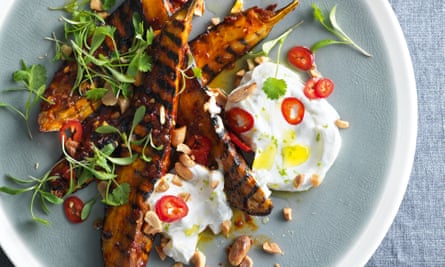
Aubergines absorb flavours really well. They do release a lot of liquid when cooked, though, so it’s important to chargrill the slices until really golden, otherwise the additional flavours will become diluted when serving.
Serves 4
aubergines 2
olive or rapeseed oil 3 tbsp
flaked sea salt 1 tsp, plus extra
dairy-free coconut yogurt 150g
lime grated zest and juice of 1
rose harissa 50g
agave syrup 30g
lemon juice 1 tsp
roasted and salted peanuts 75g, roughly chopped
red chilli ½-1, finely sliced
coriander cress or salad cress
Preheat the oven to 200C/gas mark 6. Heat a chargrill pan until hot.
Slice each aubergine lengthways into 6 long strips. Brush with the oil and season with the salt.
Chargrill both sides of the aubergine slices until deep golden. You may need to do this in a couple of batches depending on the size of your pan.
Transfer to a foil-lined baking tray and finish cooking in the oven for 15 minutes.
Mix together the coconut yogurt, lime zest and juice, and a good pinch of salt. Set aside.
Mix together the harissa, agave syrup, 4 teaspoons of water and lemon juice. Season with salt and when the aubergine is cooked, brush liberally over the top of each strip. Return to the oven for 5 minutes.
To serve, place the aubergine slices on a large plate and dot the coconut yogurt around. Scatter over the peanuts, chilli and cress.
Wareing family lasagne
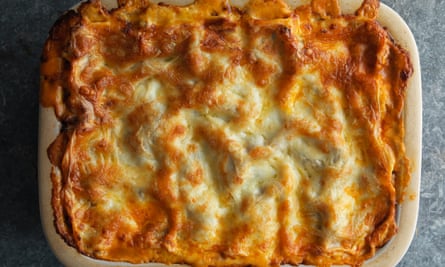
I think every home needs a family lasagne recipe, and this is one that has developed and improved over the years until it has now become a staple in the Wareing household. It’s not a quick dish to make, so we will quite often double up the recipe and put one in the freezer.
Serves 6-8
olive oil 1 tbsp
minced beef or lamb 1kg
onion 1 large, chopped
garlic 2 cloves, chopped
celery sticks 2, chopped
flaked sea salt 1 tsp
freshly ground black pepper ½ tsp
cayenne pepper ½ tsp
red wine 300ml
chopped tomatoes 2 × 400g tins
tomato ketchup 2 tbsp
tomato puree 2 tbsp
Worcestershire sauce 1 tbsp
brown sauce 1 tbsp
beef stock 500ml
bay leaves 3
thyme and rosemary 2 sprigs each
basil leaves a handful, chopped
dried egg lasagne 12-14 sheets
buffalo mozzarella 250g, sliced
cheddar cheese 100g, grated
For the white sauce
milk 600ml
onion 1 small, peeled but left whole
cloves 10
bay leaf 1
butter 50g
plain flour 50g
sea salt and freshly ground black pepper
To make the meat sauce, heat the olive oil in a large saucepan. Add the mince and fry to brown all over, breaking up any chunks with a wooden spoon. Stir in the onion, garlic and celery, and continue to fry until the onion softens. Season with the salt, black pepper and the cayenne pepper.
Pour the wine into the pan and bring to the boil, allowing it to reduce completely. Stir in the tomatoes, ketchup, tomato puree, Worcestershire sauce, brown sauce, stock and herbs. Bring to a simmer, cover and cook gently for up to 1 hour.
Once cooked, add a little more seasoning if you like and remove the bay leaves and thyme and rosemary sprigs. Meanwhile, make the white sauce. Put the milk in a small saucepan. Stud the onion with the cloves and add it to the milk along with the bay leaf. Gently bring to the boil over low heat. Remove from the heat and leave to infuse for a few minutes before removing the bay leaf and onion.
Melt the butter in a saucepan and add the flour, salt and pepper. Cook over low heat for about 1 minute to get rid of the floury taste but avoid letting it brown. Add a ladle of the infused milk and stir to combine. Continue adding the milk a little at a time until you have a thick pouring sauce. Keep hot, over a low heat.
Preheat the oven to 180C/gas mark 4. To assemble the lasagne, put a layer of meat sauce in the base of a large ovenproof dish (approximately 20cm x 20cm, 8cm deep). Sit a layer of pasta on top, pour over a layer of white sauce and dot with a few slices of mozzarella. Continue with the same process using three layers of pasta and finishing with a layer of white sauce and mozzarella. Finally, scatter with cheddar, sit the dish on a baking tray and bake for about 40 minutes, until the top is golden brown.
Chargrilled mackerel with sherry, piquillo peppers, cornichons and ricotta
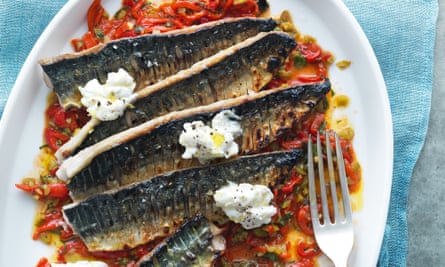
Mackerel is a versatile fish that stands up to the fierce heat of the barbecue or grill. I’ve paired it here with tangy cornichons, sweet peppers and creamy ricotta – it’s a winner.
Serves 4
ricotta cheese 100g
lemon grated zest of ½
piquillo peppers in oil 160g, finely sliced
cornichons 40g, finely chopped
capers 40g, finely chopped
mint 6 leaves, finely chopped
flat leaf parsley 8 leaves, finely chopped
extra virgin olive oil 2 tbsp
dry sherry 2 tbsp, plus 5 tsp extra
mackerel fillets 8, skin on
vegetable oil 2 tbsp
sea salt and freshly ground black pepper
Mix together the ricotta and lemon zest and season with salt and pepper. Set aside.
Combine the peppers, cornichons, capers, mint, parsley, olive oil and 2 tablespoons of sherry. Season to taste and set aside.
Heat a grill to its highest setting, or heat a barbecue until hot.
Check the mackerel for pin bones and remove any you feel.
Score the skin several times with the tip of a sharp knife to prevent curling when cooking.
Brush both sides of the fish with vegetable oil and season with salt. Place under the grill or on a barbecue, cooking the skin side first, and douse with the 5 teaspoons of sherry as it cooks.
When the skin is deeply golden and blistered, flip over to cook the flesh side for 1 minute, until just cooked through.
Put the piquillo pepper mixture on a large platter or individual plates and sit the mackerel on top. Dot the lemon ricotta over the mackerel and serve.
Roast chicken with herb, pistachio and sourdough citrus stuffing
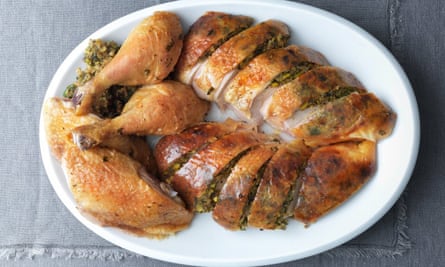
This may be labour intensive, but it’s more than worth it if you’ve got the time. Not only does this look impressive when carved into, it tastes out of this world.
Serves 4-6
chicken 1 large
bay leaves 4
lemon ½ (use the stuffing zested lemon)
orange ½ (use the stuffing zested orange)
garlic 1 bulb, halved
olive oil for drizzling
white wine or sherry 100ml
chicken stock 750ml
cornflour 2 tbsp (optional)
sea salt and freshly ground black pepper
For the stuffing
butter 50g
onion 1 small, finely chopped
celery stick 1, finely chopped
garlic 2 cloves , finely chopped
sourdough 150g, crusts removed
pistachio nuts 150g
lemon finely grated zest of ½
orange finely grated zest of ½
celery salt 1 tsp
freshly ground black pepper 1 tsp
egg 1, beaten
tarragon ½ bunch, leaves finely chopped
flat-leaf parsley ½ bunch, leaves finely chopped
coriander ½ bunch, leaves finely chopped
To make the stuffing, melt the butter in a frying pan over medium heat. Add the onion, celery and garlic and cook until softened but not coloured. Transfer to a large bowl to cool.
Put the sourdough in a food processor and blitz until you have fine crumbs. Add to the bowl with the cooled onions. Blitz the pistachios until finely chopped and mix into the bowl with the lemon and orange zests, celery salt, pepper, egg and herbs.
Slide your fingers between the chicken skin and breast flesh to create pockets. Press the stuffing under the skin, pressing and moving so that the mixture covers as much of the breast as possible. Stuff the rest into the neck end of the chicken and secure with a cocktail stick or two.
Preheat the oven to 200C/gas mark 6. Put the chicken in a roasting tray and stuff the bay leaves, lemon, orange and garlic into the bird’s cavity. Drizzle with oil and season well. Cook for 1 hour and 20 minutes, until the outside is golden. Test the chicken is cooked by inserting a skewer into the fattest part of the thigh, if the juices run clear it is done. Carefully remove the chicken from the tray (pour any juices from the cavity back into the tray), place on a board to rest for 10-15 minutes, covered loosely with foil.
Put the roasting tray over high heat, add the white wine and stir with a wooden spoon to deglaze, loosening and incorporating any sediment from the bottom of the tray. Add the chicken stock and boil until the liquid has reduced to about 600ml. If you prefer a thicker sauce, mix the cornflour with 2 tablespoons of cold water to form a paste, and add this to the pan. Boil for a couple of minutes, whisking until thickened. Add a little more seasoning, if you like, and pour into a jug.
Carve the chicken and spoon the stuffing from inside the neck and serve with gravy.
Forest fruit sorbet

This can be made all year round, using fresh berries in the summer months or frozen when fresh are out of season.
Makes about 750ml
caster sugar 150g
rosemary 4 sprigs
fresh or frozen fruits of the forest (cherries, blackberries and blackcurrants) 450g, defrosted if frozen
meringue to serve
Put the sugar, rosemary and 150ml of water in a medium saucepan and place over medium heat. Stir until the sugar has melted, then bring to the boil. Cook for 2 minutes, then add the fruit. Return to the boil, reduce the heat and simmer for 3 minutes.
Remove the rosemary sprigs and transfer the fruit mixture to a food processor. Blend until you have a smooth puree.
Strain through a sieve, using the back of a ladle to press the liquid through. Leave to cool. Pour the mixture into a metal or plastic freezerproof container.
Cover and freeze for about 1½ hours, until the base and sides are starting to freeze. Remove from the freezer and vigorously stir with a balloon whisk (or an electric whisk) until smooth.
Refreeze, and then repeat three or four more times at hourly intervals so that you end up with a smooth sorbet. If you have an ice-cream machine, follow the manufacturer’s instructions and you should have softly frozen sorbet within about 20 minutes.
Serve on its own or with crushed meringue.
Walnut burnt butter cakes

The brown butter really enhances the walnut flavour and gives a lovely deep golden colour to these light cakes.
Makes 12
walnut halves 125g
plain flour 25g
caster sugar 180g
egg whites 4
unsalted butter 125g
walnut oil for greasing
Put the walnuts and flour in a food processor and blitz until finely ground. Add the caster sugar and egg whites and blend together to combine.
Melt the butter in a small saucepan over high heat. Reduce the heat to medium and cook until it becomes a golden, nutty brown colour. Slowly pour this into the walnut mixture, blending as you pour.
Transfer the mixture to a bowl and chill in the fridge for 30 minutes.
Preheat the oven to 200C/gas mark 6. Lightly grease a 12-hole non-stick muffin tin with oil. Divide the cake mixture between the holes and bake for 15 minutes until lightly golden and just firm to the touch.
Remove from the tin and allow to cool completely on a wire rack.
From Marcus at Home by Marcus Wareing (Harper Collins, £20). Click here to order a copy for £16 from the Guardian Bookshop

Comments (…)
Sign in or create your Guardian account to join the discussion